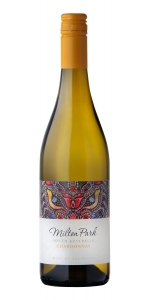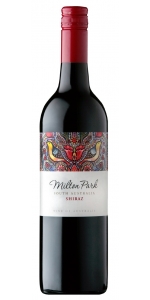Wine from Thorn Clarke - Milton Park

The Thorn Clarke Estate
The Thorn-Clarke families have been growing grapes in the Barossa and Eden Valley regions of South Australia for many years. They bought the property in 1990 (at that time it was run as a dairy). When looking for a source of grapes that would allow for high quality, affordable wines to be produced for the Milton Park range, South Eastern Australia's irrigated river regions was the answer. The Thorn-Clarke philosophy of supplying outstanding wines at each price level carries through to the Milton Park range, every measure has been taken to ensure this objective has been met. The resulting wines show character, consistency and true varietal attributes - a range of excellent wines at very reasonable prices.
The Thorn Clark Vineyards
The Milton Park name derives from the family's picturesque Milton Park property, situated in the Angaston hills, a 1.5 hour drive north east of Adelaide in the State of South Australia. The primarily Mediterranean climate enjoyed throughout the Riverland areas of South Eastern Australia, combined with fertile soils and water from the Murrumbidgee and Murray River systems makes for ideal vineyard conditions.
Thorn Clarke Milton Park Chardonnay grapes were crushed, destemmed and then pressed using a membrane press. Pressings were not used. Fermented using French Yeast at 12-15 degrees Celcius. The ferment was kept slow and cool to retain all the natural flavors of the grape. The wine was then racked and filtered. Bottling took place soon afterwards so the wine was a true expression of the grape and the terroir from which it was made.
The color is a rich vibrant green. The nose shows lifted clean, sweet fruit of apricot and peach. The palate is medium to full bodied and exhibits predominantly peach and nectarine flavors, with cloves and cardamom evident from the use of a small amount of French oak. The wine finishes full and long with a nice balance of sweet fruit and creaminess.
Thorn Clarke Milton Park Shiraz is aged for 12 months in American oak barrels.
Deep red color. The wine is deep and rich smelling with dark fruits, plums and spice with some good oak. There is very rich fruit on the palate with plums, blackberry and sweet spice from the oak. The palate is vibrant and young with a flavorsome viscous mouthfeel which will develop complexity with time. There are some slightly chewy tannins which will soften with time and there is great length of fruit flavor.
- back
Selected Options
Wineries
Categories
Pricing
Countries
Regions
Grape Types
Wineries
Organic/Free Shipping
Maggy Hawk Unforgettable Pinot Noir is made from 100 percent Pinot Noir.
HARVEST NOTES
All plants require water to grow, and grapevines are no exception. The 2021 growing season was our driest yet. The Maggy Hawk vineyard relies on rainfall in the winter and spring to fill our vineyard ponds to irrigate our vines during the summer months. These ponds ran dry a few weeks before harvest began. Fortunately, the grapes made it across the finish line without being affected by the drought. We typically harvest over 2-3 weeks. In 2021, everything was ready at once, and we harvested in just one and a half weeks. The clusters had a shorter ripening period and were harvested on the earlier side, which produced wines with intense hues, great acidity, and concentrated aromas and flavors.
WINEMAKING
Our 2021 Unforgettable Pinot Noir is crafted from a unique selection of five blocks and three clones from all corners of the Maggy Hawk vineyard. Upon arriving at the winery, we separate the individual blocks and allow the grapes to cold soak for 5 days before raising the temperature and beginning fermentation. The fruit is then pressed very gently, and the free run is kept separate from the harder pressing and racked down to barrels. The wine is allowed to go through malolactic fermentation on its own before being left to age in 30% new French oak barrels for 17 months. Finished unfined and unfitered.
Freshness, power and persistence. Unforgettable delivers a pronounced mix of fresh black cherry and red plum balanced by hints of dried lavender, bay leaf, anise and potting soil notes. A perfect balance of structured and juicy with smooth, rounded edges on the palate due to integrated tannin.
Review:
This wine is opulent, with aromas of Black cherry, red currant compote, cinnamon spice, and fresh florals on the nose. The flavors on the palate are Bing cherry, blackcurrant confiture, vanilla lime cream interwoven with dried herbs, bittersweet chocolate, earth and a long silky finish. Hold or Drink until 2032 Pair with Lamb Shoulder — Tonya Pitts
-Wine Enthusiast 94 Points
The 2021 Pinot Noir Unforgettable boasts a deeper red/ruby color and was aged in 38% new French oak. There’s more 667 clone in this blend, which reveals a darker profile in the glass, with red and black-fruited notes of black raspberries, brambly herbs, forest floor, and cedar. Medium-bodied, it has a broader shouldered feel, with lovely structure throughout and a lovely, ripe finish. It’s going to drink well over the coming 10 years.
-Jeb Dunnuck 94 Points
Domaine de Beaurenard Chateauneuf-du-Pape Blanc is made from Clairette blanche & Rose, Grenache Blanc & Gris, Bourboulenc, Roussanne, Picpoul and Picardan.
Gold bright green color. Expressive nose with pear and stone fruits aromas (peach, apricot) with jasmine and roasted almonds notes. The mouth is smooth and fleshy like stone fruit we can smell, with a long a nice finish.
Review:
Always terrific, the 2023 Châteauneuf Du Pape Blanc is no exception, and readers who love vibrant, age-worthy Rhône whites can safely buy this cuvée in just about every vintage. Based on 30% Clairette, 20% Grenache Blanc, 25% Bourboulenc, 22% Roussanne, and splashes of Picardan and Picpoul Blanc, the 2023 reveals a medium gold hue as well as textbook aromatics of pear and orchard fruits intermixed with honeyed flowers, chalky minerality, and subtle green almond nuances. This balanced, medium-bodied, vibrant white is very much in the fresh, focused, yet still textured, approachable style of the vintage.
-Jeb Dunnuck 93 Points






